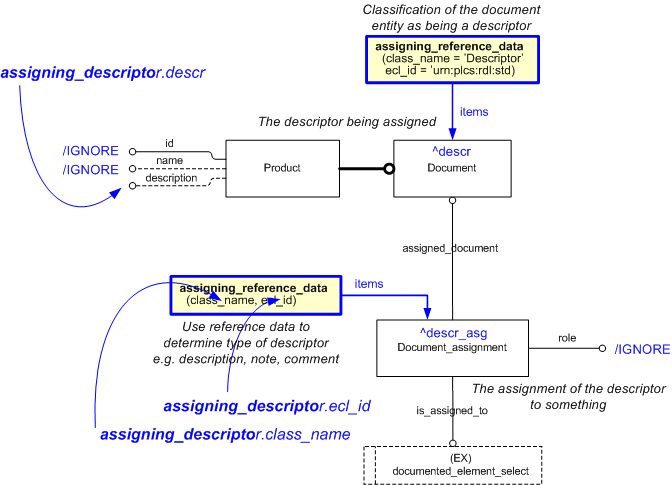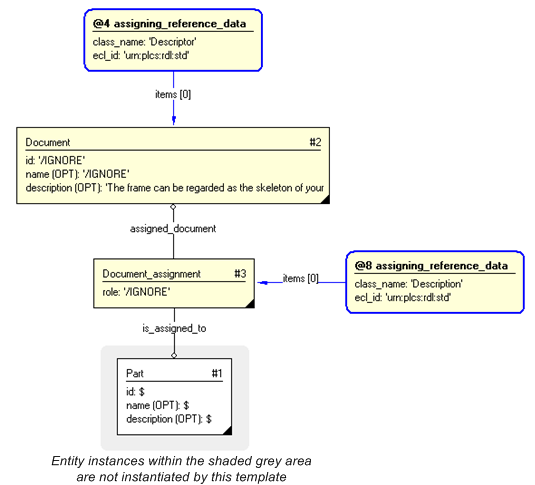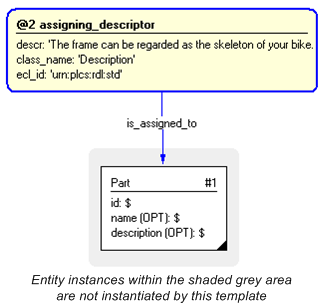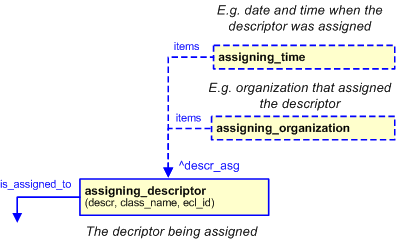| Template:— assigning_descriptor (asg_descr) |
Date: 2008/03/08 14:52:57
Revision: 1.17
|
This section specifies the template assigning_descriptor.
NOTE
An explanation of a template and the associated instantiation path is
provided in the
Template overview
section.
This template describes the assignment of descriptors to entities within a data set.
The meaning of the assignment is provided by classification. The template
excludes the usage of defined characterizations.
NOTE
A descriptor is a generic term for textual descriptions, remarks, notes etc.
The EXPRESS-G diagram in
Figure
1
shows the templates and EXPRESS entities that are required
to represent the template
"assigning_descriptor".
The text highlighted in blue shows the template parameters.
Figure 1 — Attribute values set by the template 'assigning_descriptor'.
The graphic for the template to be used in other EXPRESS-G diagrams
is shown in Figure
2
below.
Figure 2 — Graphical representations of the template 'assigning_descriptor'.
The following input parameters are defined for this template:
The text being assigned as a descriptor.
The name of the class
(
External_class)
being used to determine type of descriptor.
The following classes and their sub-classes can be used:
ecl_id (Default=urn:plcs:rdl:std,Type='URN')
The following reference parameters are defined for this template:
Allow the
Document_assignment
entity instantiated in this path to be referenced when this template is used.
%^target = $assigning_descriptor.descr_asg%
Allow the
Document
entity instantiated in this path to be referenced when this template is used.
Note: The
Document
entity can be referenced in a template path by:
%^target = $assigning_descriptor.descr%
where
target
is the parameter to which the
Document
is bound.
The instantiation path shown below specifies the entities that are to be
instantiated by the template.
The following entities are instantiated with attributes as specified:
The instance diagram in Figure
3
shows an example of the EXPRESS entities and templates that are instantiated by the template:
/assigning_descriptor(items='#1', descr='The frame can be regarded as the skeleton of your bike. It structural design is such that it can withstand a
great deal of stress.', class_name='Description', ecl_id='urn:plcs:rdl:std')/
(an illustration of the consolidated assigning_descriptor template is shown in
Figure
4 below.)
Note that two instances of the template
assigning_reference_data
are used in the diagram.
Namely:
@4 /assigning_reference_data(items='#2', class_name='Descriptor', ecl_id='urn:plcs:rdl:std')/
and
@8 /assigning_reference_data(items='#3', class_name='Description', ecl_id='urn:plcs:rdl:std')/
Figure 3 — Instance diagram instantiated by the template example
The instance diagram in
Figure
4
shows the graphic symbol for the template that is to be
used in other instance diagrams. The example template is:
/assigning_descriptor(items='#1', descr='The frame can be regarded as the skeleton of your bike. It structural design is such that it can withstand a
great deal of stress.', class_name='Description', ecl_id='urn:plcs:rdl:std')/
Figure 4 — Invocation of template - graphical presentation
The following section details how the
assigning_descriptor
template can be optionally characterized by assigning
other constructs to it. These are characterizations commonly
applied to the template. The ISO 10303-239 EXPRESS model may enable
other assignments to the entities instantiated by the template.
The EXPRESS-G diagram in Figure
5
shows the possible characterizations of the template
"assigning_descriptor".
Figure 5 — Examples of optional characterizations of a descriptor
The following characterizations may apply:
Characterization Assigning date time
NOTE this characterization is optional.
Dates may be associated with the assignment of a descriptor (reference parameter ^descr_asg) by
using the template
assigning_time.
For example, the date and time when a descriptor was assigned may enable simple version management.
Characterization Assigning organization
NOTE this characterization is optional.
Organizations may be associated with the assignment of a descriptor (reference parameter ^descr_asg) by
using the template
assigning_organization.
This enables multiple descriptors to assigned to the same object, but from different perspectives.





